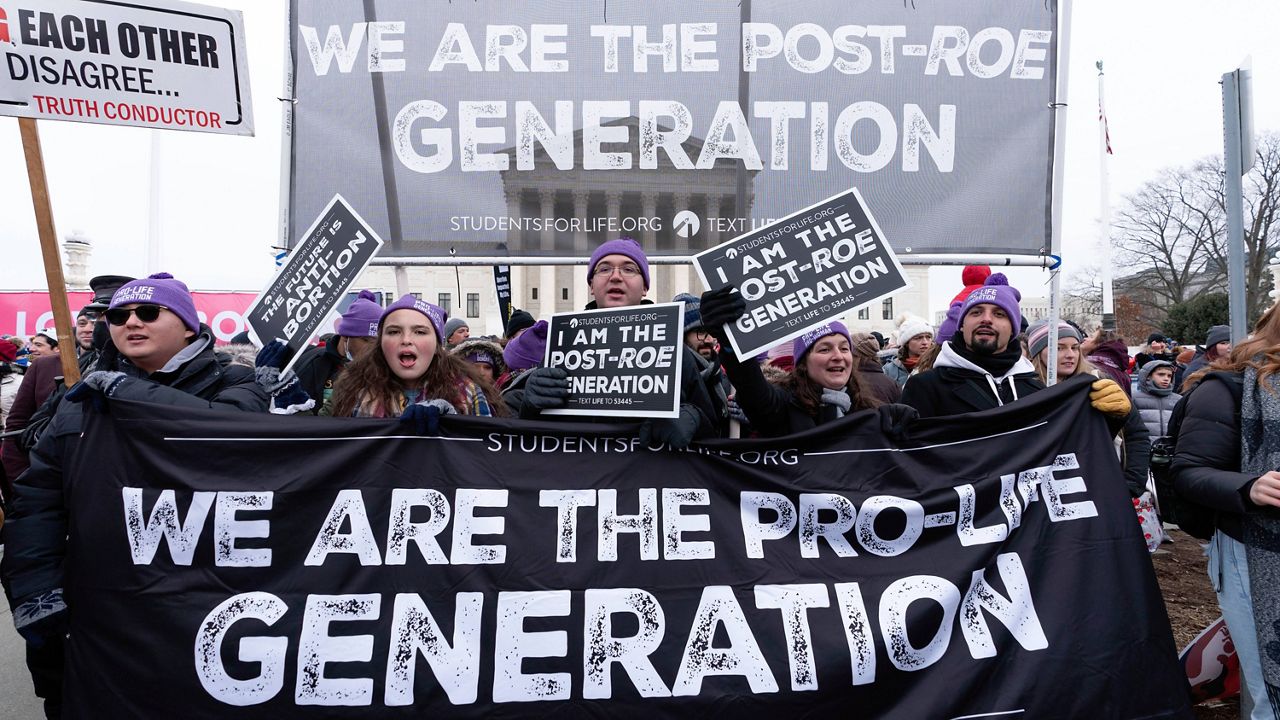Anti-abortion activists will have multiple reasons to celebrate — and some reasons for unease — when they gather Friday in Washington for the annual March for Life.
The march, which includes a rally drawing abortion opponents from across the nation, has been held annually since January 1974 — a year after the U.S. Supreme Court’s Roe v. Wade decision established a nationwide right to abortion.
What You Need To Know
- Anti-abortion activists will have multiple reasons to celebrate — and some reasons for unease — when they gather Friday in Washington for the annual March for Life
- The march, which includes a rally drawing abortion opponents from across the nation, has been held annually since January 1974 — a year after the U.S. Supreme Court’s Roe v. Wade decision established a nationwide right to abortion
- Friday will mark the first gathering since the high court struck down Roe v. Wade
- Since then, 12 Republican-governed states have implemented sweeping bans on abortion, and several others seek to do the same. But those moves have been offset by votes on ballot measures
This year’s gathering — 50 years after that decision — will be the first since the high court struck down Roe in a momentous ruling last June.
Since then, 12 Republican-governed states have implemented sweeping bans on abortion, and several others seek to do the same. But those moves have been offset by other developments. Abortion opponents were defeated in votes on ballot measures in Kansas, Michigan and Kentucky. State courts have blocked several bans from taking effect. And myriad efforts are underway to help women in abortion-ban states either get abortions out of state or use the abortion pill for self-managed abortions.
“It’s almost like the old wild, wild West … everything is still shaking out,” said Carol Tobias, president of the National Right to Life Committee.
With numerous Democratic-governed states taking steps to protect and expand abortion access, Tobias likened the current situation to the pre-Civil War era when the nation was closely divided between free states and slave states.
“I will not be surprised if we have something like that for a few years,” she said. “But I do know that pro-lifers are not going to give up — it’s a civil rights issue for us.”

The theme for this year’s March for Life is “Next Steps: Marching Forward into a Post-Roe America.” Scheduled speakers include Hall of Fame football coach Tony Dungy and Mississippi Attorney General Lynn Fitch, who won the Supreme Court case that overturned Roe.
The president of March for Life, Jeanne Mancini, depicted the June ruling as “a massive victory for the pro-life movement.”
“But the battle to build a culture of life is far from over,” she said. “March for Life will continue to advocate for the unborn and policies that protect them until abortion becomes unthinkable.”
Prospects for any federal legislation restricting abortion nationwide are negligible for now, given that any such measures emerging from the Republican-led House would face rejection in the Democratic-led Senate. The main battlegrounds will be in the states.
Since June, near-total bans on abortion have been implemented in Alabama, Arkansas, Idaho, Kentucky, Louisiana, Mississippi, Missouri, Oklahoma, South Dakota, Tennessee, Texas and West Virginia. Legal challenges are pending against several of those bans.
Elective abortions also are unavailable in Wisconsin, due to legal uncertainties faced by abortion clinics, and in North Dakota, where the lone clinic relocated to Minnesota.
Bans passed by lawmakers in Ohio, Indiana and Wyoming have been blocked by state courts while legal challenges are pending. And in South Carolina, the state Supreme Court on Jan. 5 struck down a ban on abortion after six weeks, ruling the restriction violates a state constitutional right to privacy.
The Guttmacher Institute, a research group which supports abortion rights, says the overall result is “a chaotic legal landscape that is disruptive for providers trying to offer care and patients trying to obtain it.”
“When people do not have access to abortion care in their state, they are forced to make the difficult decision to travel long distances for care, self-manage an abortion or carry an unwanted pregnancy to term,” Guttmacher staffers Elizabeth Nash and Isabel Guarnieri wrote last week.
Looking ahead, some anti-abortion leaders hope the Republicans nominate a 2024 presidential candidate who will aggressively push for nationwide abortion restrictions, rather than keep it as a state-by-state matter.

“The approach to winning on abortion in federal races, proven for a decade, is this: state clearly the ambitious consensus pro-life position and contrast that with the extreme view of Democrat opponents,” said Marjorie Dannenfelser, president of SBA Pro-Life America.
Dannenfelser says she’s not surprised by the divisive ups-and-downs that have unfolded since the June ruling.
“This is what it looks like when democracy is restored and we have a voice in the debate,” she said. “For 50 years, we had no voice because the judiciary was always going to shield public opinion from having an effect on the law.”
“We always knew it wouldn’t be a straight line (after Roe’s repeal),” she said, adding "we know neither side is going to lay down and die.”
Professor Kathleen Sprows Cummings, director of the University of Notre Dame’s Cushwa Center for the Study of American Catholicism, suggested the anti-abortion movement may suffer from a perception among many Americans that it’s more concerned with controlling women’s bodies than helping them cope with unintended pregnancies.
“It’s about consolidating their political power, more than about babies," she said.
Some abortion opponents are trying to counter such perceptions. In Texas, for example, anti-abortion groups are urging lawmakers to spend more money on services for pregnant and parenting Texans, including expanding Medicaid coverage for mothers.
According to Texas Right to Life, the state's new abortion ban has had a major impact — it says only 68 abortions were recorded by state health officials in July 2022, compared to 4,879 in July 2021.
The group noted the data does not include illegal, unreported abortions — which are widely believed to be increasing as women obtain abortion pills by mail from overseas or from Mexico suppliers.
Charles Camosy, a medical humanities professor at Creighton University School of Medicine who opposes abortion, has analyzed the high-profile election defeats suffered by the anti-abortion movement. Voters in Kansas and Kentucky rejected constitutional amendments that would have declared there is no right to abortion; Michigan voters approved an amendment enshrining the right to abortion in the state constitution.
“Pro-lifers have clearly and badly lost the PR battle since June and this has shaped how people are voting,” Camosy said via email. He said abortion-rights supporters were better organized and better funded, while many anti-abortion politicians either avoided the issue or sounded too extreme.
“There are obviously very good things that have happened, however,” added Camosy, citing the drop in abortions reported in states with bans.
“Pro-lifers also now relish the chance to actually debate the issues in a democratic, open context ... as opposed to constantly running into the fiats of various courts,” he said. “We may lose some battles early on... but it is worth it to have the debates.”



